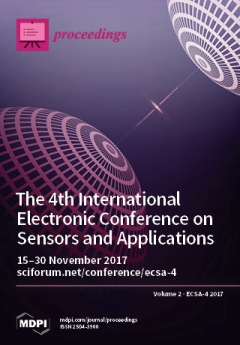Proceedings, 2018, ECSA-4 2017
The 4th International Electronic Conference on Sensors and Applications
Online |15-30 November 2017
Issue Editors:
Stefano Mariani, Politecnico di Milano, Italy
Francesco Ciucci, The Hong Kong University of Science and Technology, Hong Kong
Dirk Lehmhus, University of Bremen, Germany
Thomas B. Messervey, R2M Solution s.r.l., Italy
Alberto Vallan, Politecnico di Torino, Italy Stefan Bosse, University of Bremen, Germany
- Issues are regarded as officially published after their release is announced to the table of contents alert mailing list.
- You may sign up for e-mail alerts to receive table of contents of newly released issues.
- PDF is the official format for papers published in both, html and pdf forms. To view the papers in pdf format, click on the "PDF Full-text" link, and use the free Adobe Reader to open them.



